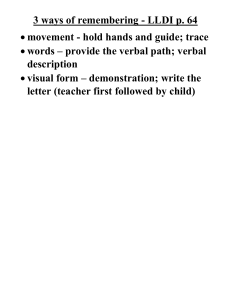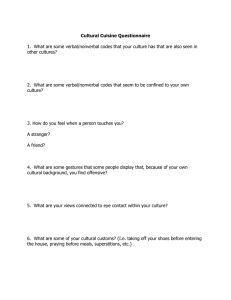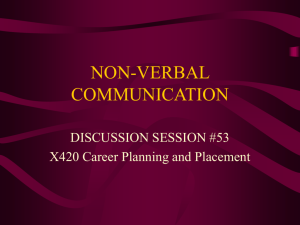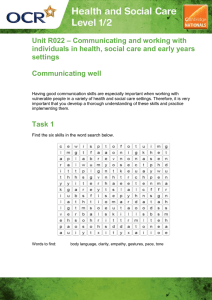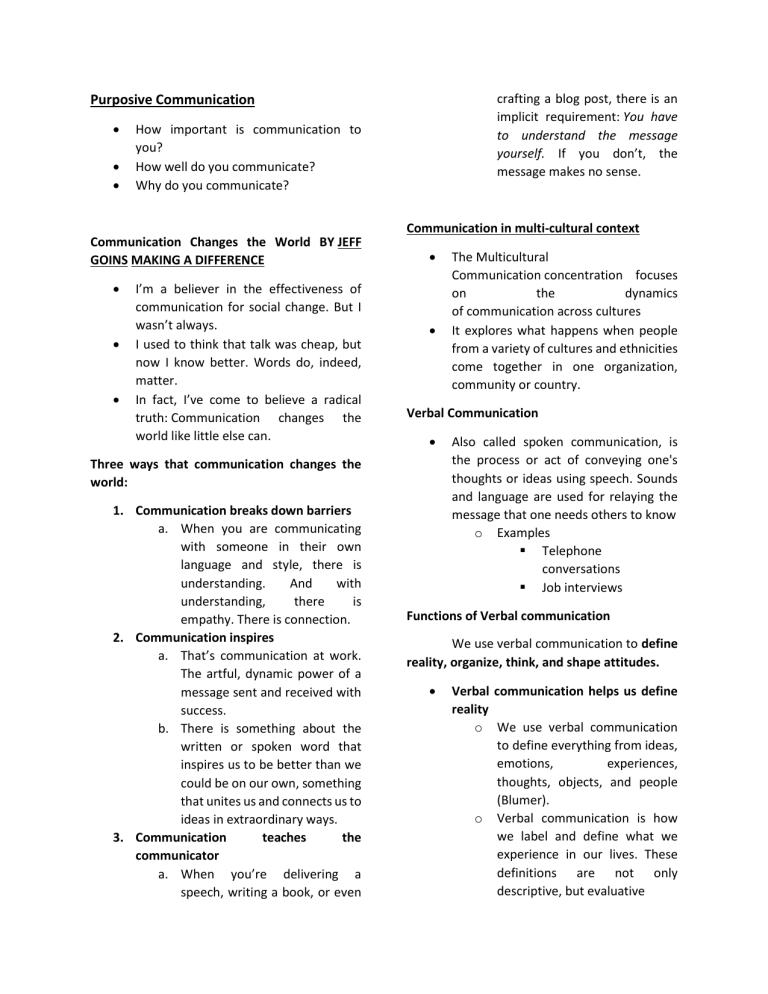
crafting a blog post, there is an implicit requirement: You have to understand the message yourself. If you don’t, the message makes no sense. Purposive Communication How important is communication to you? How well do you communicate? Why do you communicate? Communication in multi-cultural context Communication Changes the World BY JEFF GOINS MAKING A DIFFERENCE I’m a believer in the effectiveness of communication for social change. But I wasn’t always. I used to think that talk was cheap, but now I know better. Words do, indeed, matter. In fact, I’ve come to believe a radical truth: Communication changes the world like little else can. Verbal Communication Three ways that communication changes the world: 1. Communication breaks down barriers a. When you are communicating with someone in their own language and style, there is understanding. And with understanding, there is empathy. There is connection. 2. Communication inspires a. That’s communication at work. The artful, dynamic power of a message sent and received with success. b. There is something about the written or spoken word that inspires us to be better than we could be on our own, something that unites us and connects us to ideas in extraordinary ways. 3. Communication teaches the communicator a. When you’re delivering a speech, writing a book, or even The Multicultural Communication concentration focuses on the dynamics of communication across cultures It explores what happens when people from a variety of cultures and ethnicities come together in one organization, community or country. Also called spoken communication, is the process or act of conveying one's thoughts or ideas using speech. Sounds and language are used for relaying the message that one needs others to know o Examples Telephone conversations Job interviews Functions of Verbal communication We use verbal communication to define reality, organize, think, and shape attitudes. Verbal communication helps us define reality o We use verbal communication to define everything from ideas, emotions, experiences, thoughts, objects, and people (Blumer). o Verbal communication is how we label and define what we experience in our lives. These definitions are not only descriptive, but evaluative o We have choices for how we use verbal communication to define our realities Verbal communication helps us organize complex ideas and experiences into meaningful categories o We use verbal communication to organize seemingly random events into understandable categories to make sense of our experiences. o We highlight certain qualities, traits, or scripts to organize outwardly haphazard events into meaningful categories to establish meaning for our world. Verbal communication helps us think o Without verbal communication, we would not function as thinking beings. o The ability most often used to distinguish humans from other animals is our ability to reason and communicate. o With language, we are able to reflect on the past, consider the present, and ponder the future. o We develop our memories using language Verbal communication helps us shape our attitudes about our world. o language determines thought o People who speak different languages, or use language differently, think differently o Non-verbal communication Refers to the use of wordless cues in order to convey a message. These cues include facial expressions, hand gestures, body language, and the tone, pitch, and volume of voice. Even when one is using words, there is also nonverbal communication involved. o Examples: shaking your head smiling 5 Key Elements to Successful NonVerbal Communication: 1. Eye Contact a. It indicates interest, attention and involvement. 2. Gestures a. A gesture is a non-facial body movement intended to express meaning. Gestures may be articulated with hands, arms or body, and also include movements of the head, face and eyes such as winking, nodding or rolling your eyes. 3. Posture a. Your posture tells a powerful, non-verbal story. b. Positive body posture transmits a message of authority, confidence, trust and power 4. Smile and Laughter a. People who laugh and smile, even when they don’t feel especially happy, make their brain’s left hemisphere surge with electrical activity. b. When you laugh, every organ in your body is affected in a positive way. As with smiling, when laughter is incorporated as a permanent part of who you are, it attracts friends, improves health and extends life. 5. The Power of the Touch a. The power of the touch, whether it be your handshake, touch on the elbow, a high five or pat on the back demonstrates positive impact. o c. o Cultural and Inter Cultural Awareness Intercultural dialogue Cultural Diversity o Diversity refers to the manifold ways in which the cultures of groups and societies find expression. These expressions are passed on within and among groups and societies. o Main heritage of humanity. It is the product of thousands of years of history and the fruit of collective contributions by all peoples through their languages, ideas, techniques, practices and creations. o It is an essential component of social harmony, citizenship and the creation of a peaceful society.’ The arts are a strong and universal tool for promoting mutual understanding and peace, and practicing the arts is a powerful way of socializing with others. Essential knowledge, skills and attitudes related to Cultural Awareness Cultural knowledge Includes an awareness of local, national and international cultural heritage and their place in the world. Covers a basic knowledge of major cultural works, including popular contemporary culture. Skills o Relate to both appreciation and expression o Include the ability to relate one’s own creative and expressive points of view to the opinions of others and to identify and realize social and economic opportunities in cultural activity. Attitude o A solid understanding of one’s own culture and a sense of identity can provide the basis for an open attitude towards and respect for diversity of cultural expression. o A positive attitude also covers creativity, and the willingness to cultivate aesthetic capacity through artistic self-expression and participation in cultural life Cultural education in the context of multiculturalism offers specific possibilities, e.g.: To experience and appreciate different, unfamiliar cultural forms of expression and to evaluate their relevance in respect of oneself; To observe cultural differences and use the resultant knowledge to enrich one’s own life and to improve communication with others; To perceive objects, habits and forms as creative solutions for different cultural tasks in specific contexts; To compare cultures, appreciate diversity as a value in itself, and explore and shape individual spaces of experience; To be able to evaluate and select Communication Process Contexts In the intercultural context, cultural education can foster the following skills: To understand culture as a construct and to relate and link cultural concepts; To interpret and evaluate cultural phenomena with regard to individual, group and Universal criteria; To initiate and create ways of dialogue and interaction; To detect, understand and estimate conflict potential; To develop forms of cultural interaction within the framework of human rights affects the process of sending and receiving of messages; semantics or meanings, choice of channels, words and methods of delivery Context includes: A transcultural approach will emphasize the following aspects: To discover overarching or universal processes in developing culture; To decode specific cultural phenomena as transcultural phenomena; To gauge intentions and consequences; To experience and create hybridity; To act in the public space. Elements of Communication 1. Filipino Identity Heritage education Art specific skills Cultural Identity Lifelong learning Self formation Intercultural competencies Settings or environment 1. family, school, workplace, religious communities Social relationships 1. friends, husband and wife, parent child, colleagues/bosssubordinate in the office Scenes which include place, time and occasion 1. Business meeting, job interview, social gathering parties, weddings, etc.) Culture 1. history, tradition, beliefs, norms, values Sender - source of idea (from WHOM) the message will only be as good and valid as its source Must be able to use the language that the receiver understands. Correct grammar Phonetics Choice of words or jargons for an appropriate audience Sentence construction Discourse competence Delivery 2. Good voice projection Use of appropriate eye contact Proper articulation of words and emphasis on important words Completeness o To avoid ambiguity, messages should not leave out important details that a receiver expects to know. o Answer: What, Who, When, Where, Why and How 3. Channel - is the medium (HOW) The choice of channel may depend on the availability, practicality, and its impact on the receiver. Message -the idea being communicated (WHAT) The 5 C’s in Communication Courtesy o Also known as politeness. Ways to demonstrate courtesy: o Using polite words and tone to show respect to the receiver of the message. o Applying tact and diplomacy o Developing the “we” attitude using positive words instead of negative o Being considerate of the feelings of the receiver o Selecting gender-free terms o Responding promptly to important messages Clarity o May involve correct word usage, grammar, pronunciation, sentence construction and delivery. o Messages which are unclear oftentimes do not achieve their desired effect Conciseness o Is saying what needs to be said in as few words as possible. o Avoid flowery words. o Remember: “Our goal is to communicate and not to impress.” Concreteness o This refers to being specific.providing example when necessary makes a message more comprehensible Channels: 4. Telephone, Radio, Television, Printed texts (books, newspapers, magazines, journals, posters, etc.), Communication technologies (smart phones, tablets, computers) Receiver - where the message is going (to WHOM?) Must have good listening and comprehension skills Eliminate all possible distractions or noises o Types of noise (physical, environmental, psychological, emotional) Sharpness of cognition through continuous studies and acquisition of information and knowledge Types of Communication and way to use them Verbal Communication o Use of language to transfer information through speaking or sign language. o It is one of the common types and most important since it is efficient o Can be supported by non-verbal and written communication. Use a strong, confident speaking voice Use active listening Avoid filter words Avoid industry jargon when appropriate Non-Verbal o The use of body language, gestures, and facial expressions to convey information to others o Can also be used unintentionally How to develop? Notice how your emotions feel physically Be intentional about your nonverbal communications Mimic non-verbal communications you find effective Visual o Is the act of using photographs, arts, drawings, and sketches to convey information How to develop? Ask others before including visuals Consider your audience Written o The act of writing, typing or printing symbols like letters and numbers to convey information How to develop? How to develop? Only add visuals if they add value Make them clear and easy to understand Strive for Simplicity Don’t rely on tone Take time to review written communications Keep a file of writing you find effective or enjoyable. Culturally Appropriate terms, expressions and images Communicating in a culturally appropriate manner, means that you are working to understand and accept the culture of your peers. It's all about understanding culture and working effectively with each other's cultural influences. Personal Awareness o Willingness to put aside your own beliefs o Avoid some misguided stereotypes about other cultures o Considering values like: How the world should be How people should act on specific situations How people interact with money, family, relationships, power and gender roles Inclusive Communication o Equipping yourself to understand your peers o Make sure that you: Respectful to other cultural beliefs, practices and attitudes. Considering other’s point of view Be polite and listen with genuine interest Respect your peer’s privacy right about their culture. o Consider how your peers want to be spoken to. All forms of Communication o Be aware of cultural differences even in non-verbal communication. o Remember that up to 2/3 of a message come across from facial expressions, gestures, postures, and tone of voice. Take the initiative o Talk to people to find out about their values and beliefs. o Remember that communication is a two-way street. Work with interpreters o It is important for an interpreter to have skills to provide accurate interpretations hence, they need to have enough knowledge on different cultures. We’re all equal o Lacking understanding of culture doesn’t mean that it is less. Having trouble of understanding others doesn’t mean they should be treated differently either. Cultural Diversity is attempt to a sincere understanding of other cultures and individuals. Keep in mind that whether you speak same language or not it is necessary to understand and navigate around cultural differences. Cultural Sensitivity Skills that permits us to learn about and understand others who came from a different cultural background.
